How to pinch peppers in a greenhouse?
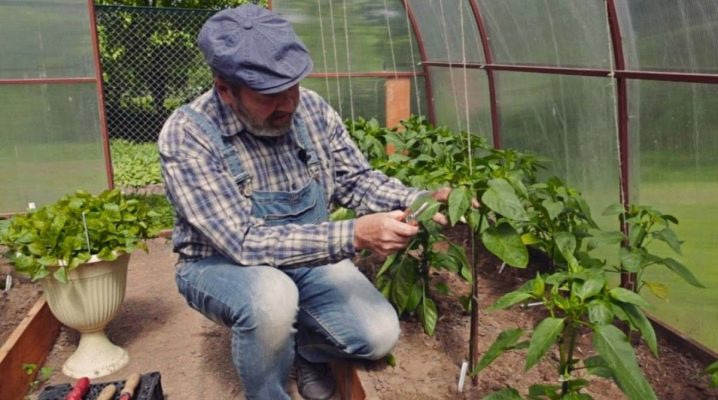
Vegetables planted in the greenhouse require special care. It differs in many respects from grooming procedures in open ground. There are a number of basic rules that must be followed when pinching peppers in a greenhouse. In this article, we'll show you how to do this.
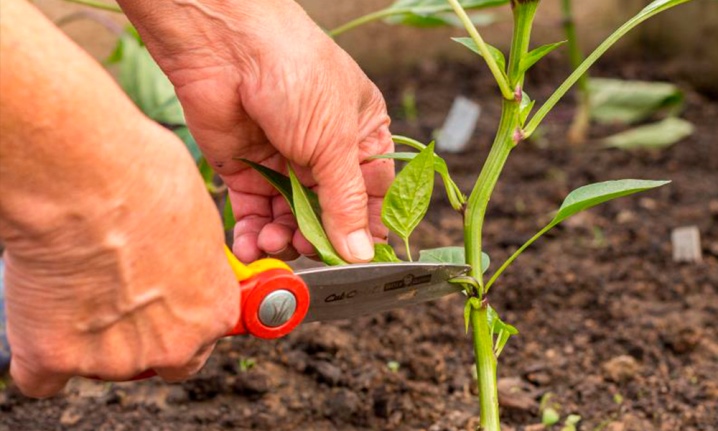
The need for a procedure
Many summer residents are engaged in the cultivation of peppers in greenhouse conditions. This crop must be properly cared for so that it shows good yields and looks tidy. The plant requires a special procedure - pinching. It is thanks to her that the bush can be given the correct shape. Patching is a popular agricultural technique, regardless of where the culture grows.

This procedure has many good results.
-
Due to the correct pinching, the necessary nutrients are consumed exclusively for their intended purpose, namely, for the development of juicy and fleshy pepper fruits. The growth of unpromising shoots is not supported by anything.
-
Due to the competent removal of stepchildren, absolutely all the constituent parts of the bush can receive natural light in the required volumes.
-
When the plant is freed from stepchildren, it ventilates much better and more freely.
-
The very condition and quality of the pepper crop increase if the summer resident conducts pinching operations.
-
The fruits that the bush gives take on more impressive sizes if the plant was initially rid of unnecessary vegetation.
-
Passionking promotes the active growth of ovaries, which is a big plus.
-
The flowering process of crops that have passed the pinching procedure is much longer.

If the summer resident wants the plant in the greenhouse to give a good harvest and fully receive everything that he needs for growth, then pinching is necessary. It is strongly not recommended to neglect such a procedure.
You just need to take into account that the removal of stepchildren has its drawbacks.
-
Due to the cutting of the stepchildren, the growth of the pepper bush may slow down. For some gardeners, this fact is very important.
-
If the process of forming a bush was implemented incorrectly, then the ovaries may die, and with them the entire plant as a whole.

Stealing of different varieties
Peppers need to be grown in a polycarbonate greenhouse according to certain rules. Much depends on the variety to which the plant belongs. So, the procedures for short and tall types of pepper will differ.
Undersized
Grazing of low-growing varieties of pepper is done so that the culture is of the highest quality, demonstrates the best taste characteristics. In order for such an agrotechnical operation to be successful and trouble-free, in the case of low varieties, it is required to remove those shoots that are on top. They must be left up to the 7 most powerful and viable. Any leaves that remain will also need to be removed. This must be done so that the bush is not unnecessarily thickened.

Thanks to the above manipulations, the ventilation of the plants in the greenhouse will improve, and the access to natural light will increase.
Short varieties often need to be tied up. This operation should not be neglected.
It is necessary to take into account the fact that pepper bushes are very fond of light, therefore they are always actively drawn to it. In addition, the culture in question treats neighboring plants well. Doesn't need large gaps left between them. Most often, plantings grow 15 centimeters apart - this is the optimal and safe distance.

Tall
The pinching procedure for tall varieties of peppers has certain differences. Let's consider step by step how such a plant care work should be done correctly.
-
When the culture reaches a sufficient level of height (from 9 to 11 leaves will form on the bush), they are engaged in the formation of a crown of 2-3 stems. For this purpose, a sufficient number of the healthiest and strongest shoots from the developing ones are left behind the first flowering and crown ovary.

- The ovary must be carefully removed... If this is not done, then most of the forces will be directed specifically to this fruit, although at this time the immature seedling needs to grow on its own.
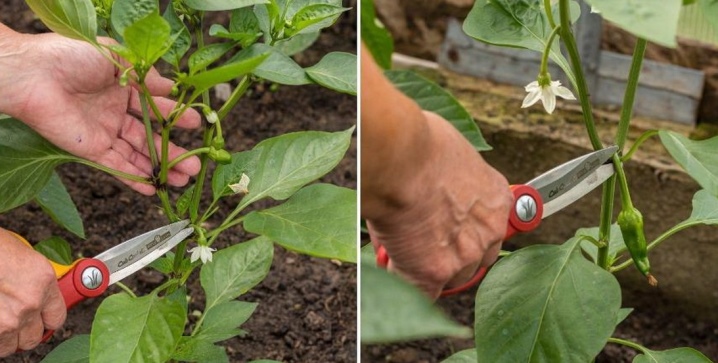
- Cutting the ovary of the plant will provoke a very active branching. Flowers appear in areas with branching. To get a large-sized and fleshy fruit for seeds, the first "crown" flowering is not removed. Bushes with rather large fruits, but few in number, can grow from such seeds.

- For high-quality thinning of the bush, greenhouse pepper is pinched. This operation will prevent the accumulation of nutrients in the tops. In each of the forks, the highest quality and most powerful shoots are left - everything else is cut off. In this case, you should wait for the formation of ovaries on a fresh branch.
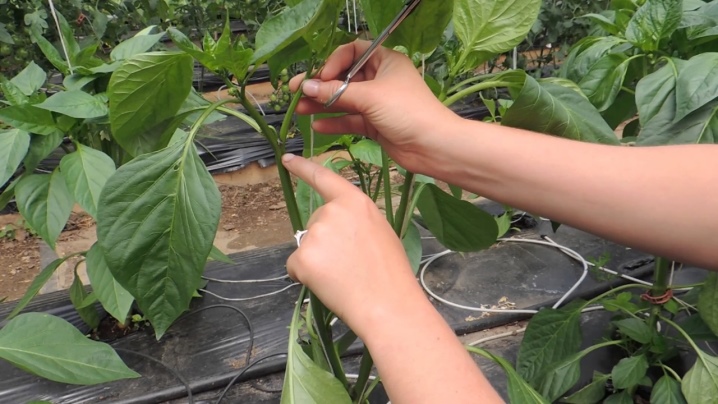
- On the shoot that is being removed, one leaf must be left... It will be needed to feed the fruit ovary in front of the stepson.
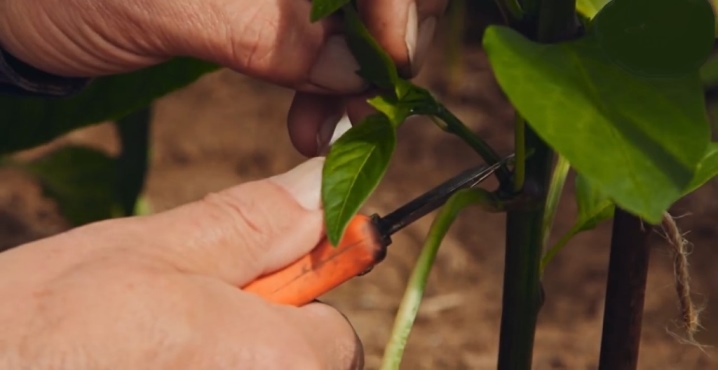
- The stepson can not only immediately cut off, but also pinch. Due to such actions, the growth of unnecessary shoots that will not be needed will be limited.

- The same is required to do with all the remaining forks. - stepchildren are removed, except for the strongest, which forms the stem.

-
As in the case of processing low-growing varieties, when working with tall plants, excess foliage is also cut, which creates a shade for the ovaries.
We must not forget that tall plantings (for example, bell peppers) always need timely tying.
In this case, the support must be designed in such a way that it remains possible to tie each skeletal shoot separately.

Follow-up care
The pinching scheme does not cause any particular difficulties even for novice gardeners, but after that the bushes in the greenhouse will need to be properly cared for. It will not be possible to achieve a good crop yield if you neglect the appropriate care procedures.
Consider how to properly care for peppers that have undergone the pinching procedure.
-
Watering is essential for plant health. It must be regular. The summer resident must always monitor the degree of drying of the upper soil layer. However, too abundant watering should not be carried out - in everything it is necessary to observe the measure.
-
Another important care operation is loosening. It should be done at the end of each watering done.
-
It is necessary to regularly remove absolutely all the weeds that have grown there from the garden. Timely removal of weeds is the key to good planting health, so it should not be neglected in any case.
-
The summer resident should not forget about fertilizing the peppers growing in the greenhouse.... In May and June, nitrogen-containing formulations are usually added. In the period from August to September, it is advisable to make top dressing based on phosphorus and potassium.
The final pinching must be done in early September.



When is it forbidden to pinch?
There are situations in which it is not allowed to engage in pinching greenhouse peppers.
-
Do not remove stepchildren from pepper bushes if the weather is dry. In conditions when irrigation interruptions take place in the greenhouse, the more shade the bush creates, the better for it, because then moisture evaporation from the soil is reduced. If the drought persists, then pinching is postponed until the irrigation systems start working.
-
It is not allowed to pinch such greenhouse peppers that have signs of certain diseases.... Cutting the shoot weakens the plant even more, causing considerable stress on it. Infectious diseases progress rapidly under these conditions.
-
If there are large gaps between the bushes, then pinching should also not be done. It must be remembered that pepper is a "companionable" plant. He feels very good and develops great, touching the foliage of the plantings next door. If a plant grows alone, then it already experiences stress, and pinching will only aggravate the situation.
-
It is not recommended to engage in cutting stepchildren when the height of the pepper bushes is less than 20 cm... It is at such moments that the plantings should be left with the possibility of active and free development.
-
There are some varieties of pepper that do not need the pinching procedure initially. Such plants cannot be processed.
-
It is not recommended to engage in pinching peppers in a greenhouse if the summer resident has absolutely no experience in this matter. This procedure is very responsible and important. It requires certain knowledge in the field of plant life processes.




Useful Tips
It is necessary to cut off the stepchildren of pepper grown in greenhouse conditions in accordance with all the rules and requirements. In doing so, it makes sense to listen to a number of important and useful tips.
-
It should be borne in mind that measures for the formation of pepper bushes can only be carried out if it is absolutely healthy... If the landing suffers from one or another ailment, then pinching can kill her.
-
It is forbidden to cut off stepchildren from those greenhouse peppers that are in the stage of active growth and development.... You should not rush with this procedure, as it can cause very serious harm.
-
The process of forming the planted bushes itself should be carried out in the morning, as well as at the end of evening watering. This must be done so that all the moisture in the soil layers productively saturates the culture. This primarily concerns the roots of the pepper.
-
Removal of stepchildren should be done only with perfectly clean instruments.... The knife, which will cut off unnecessary shoots, must be sharpened well. This is necessary so that pathogenic bacteria and infections do not get into the just made incision.
-
For pinching, the summer resident must first prepare a good disinfectant solution... They need to wipe the knife with which the cut will be carried out. If scissors are used, they must also be disinfected. This should be done after processing each of the bushes. An effective solution can be prepared from potassium permanganate or bleach. A concentration of 1 or 2 percent should be adhered to.
-
As mentioned above, some peppers do not need to be pinned.... If you do not want to engage in such operations, you should take a closer look at the options "Winnie the Pooh", "Kapitoshka". There is no need to remove stepchildren from them.
-
Pepper pinching should be done with utmost care. The summer resident must act carefully and carefully. Cutting off excess shoots too casually can damage the plant in the greenhouse. This will lead to many negative consequences.
-
Grazing is a useful and effective procedure if the gardener needs the plants planted in the greenhouse to develop at a high rate. In addition, the plantings treated in this way are more resistant to the development of many dangerous diseases.
-
Do not rush to start cutting the stepchildren of pepper in the greenhouse. First, the summer resident needs to very carefully and scrupulously examine each of the bushes. Their condition should be good. If a sick specimen is found, then the procedure should be postponed in relation to it.
-
Plants that are planned to be pinned need to be examined for not only diseases, but also attacks of parasites and pests... If such problems were found, then the processing of the bush should also be postponed.
-
If an inexperienced and novice gardener is going to do pinching, then he should strictly adhere to the step-by-step instructions... It must be remembered that this operation is very important, there is no way to make mistakes here - this can seriously harm the plantings in the greenhouse.















The comment was sent successfully.